Blog
Blog
5 ways Camping Changed my Life
NOVEMBER 14, 2018 | BY CRISTINA SCHOOLER
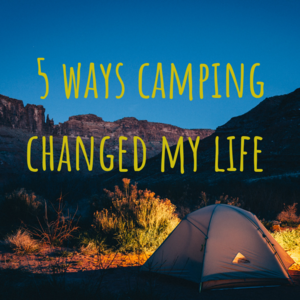
One of the most beautiful aspects of camping is realizing just how much we don’t need. There is sage advice when thinking less is more.
One of the greatest gifts of camping has given me is reminding me that a life of less is so much more.
Camping has helped me in so many ways, here are just a few.
Living with Less
Camping and Backpacking forces you to be sheltered and surrounded by less. I’m always amazed at how blissfully happy I am with my backpack and just a few items. This concept has really made me re-evaluate even the smallest of habits that may not seem like a lot in the short run but add up over time.
Limiting Distractions
The older I get, the more I realize just how much my physical environment affects my ability to concentrate. When you are in the wilderness, everything is in tune to the moment as there are no other distractions like phones, traffic, loud noises- only the pristine environment around you. Understanding this principle has been of tremendous value to my life as it encouraged me to take hard look at what was always distracting me in my home- papers on the coffee table, extra boxes lying around, place holders not having anything. I started carving out just 20 minutes a day to tend to my home so it never started to pile up as a mess with laundry, papers, my business camping gear (how many times have i had tents on my floor?) :)
Bringing Nature into the Home
When you are out camping and backpacking you find this certain gratitude of the routine that comes from packing up camp, organizing your backpack. Everything has it’s placed and every item it’s value. The more time I spent outdoors, the more I actually take pride in my home, my space and want to curate more nature within the home. The more I filled it with aromatherapy diffusers, plants, crystals and things of the earth, the less I cared about the miscellaneous items around my home that had no value or didn’t bring me joy. If you are starting a minimalist journey, I highly recccommend The Magical Art of Tidying Up.
Remembering That my Human Relationships Always Come First
This is perhaps the biggest and most fundamental reason I do what I do. Being a part of outdoor group experiences taps deep deep into my most primal sense of belonging. Every fiber of my being is alive when I’m in the wilderness setting up camp, enjoying conversation or helping each other out. We need each other more than we need anything else on this planet, we are wired as animals to work in and thrive in groups.
Eating/Moving With The Cycles of Life
As my possessions and habits that don’t serve me become less appealing, I have more time just to feel into life. I naturally crave foods that are in each season, like potatoes in the winter and strawberries in the summer. For periods of months I’ll go through more grounding meditation and yoga in the winter and in the summer I”ll swim, bike and climb an whole lot more. I listen to what my body needs and move accordingly. There is this voice within that is allowed to come up when you start shedding all of the things you don’t need in your life, you just have room to think and feel everything more.
How has camping changed your life?
Stay wild,
Cristina
ABOUT ME
NOVEMBER 7, 2018 | BY CRISTINA SCHOOLER
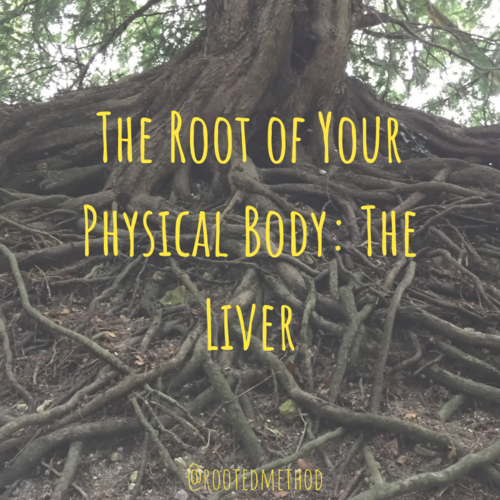
Even if you are eating healthy, doing all the yoga, spending time in nature, it is crucial to support your liver’s function.
But why?
Even if you are eating healthy, doing all the yoga, spending time in nature, it is crucial to support your liver’s function.
But why?
Without the liver, it’s impossible to have a properly working metabolism, healthy circulation, balanced hormones, clean blood, and strong digestion.
Boosting liver health to remove toxins from the body is an integral part of Ayurvedic, yogic and naturopathic medicine. It’s the liver’s job to help dissect the nutrients available in foods once they reach the digestive system spread them throughout the body via the bloodstream and eliminate toxic waste that’s left behind.
Aka, if you’re liver isn’t functioning well, you won’t be absorbing all of the nutrients you are eating from your food.
Here are five ways you can support your liver’s ability to detox.
Eat probiotic foods daily:
Yes, pre and probiotic supplements will help you but ultimately your nutrients should be coming from your food. Here are some examples of probiotic foods:
Kombucha
Kefir
Kimchi
Cultured Vegetables
100% plain Greek Yogurt (no sugar added, y’all)
Eat Bitter Green Plants/Veggies:
Mustard greens
Chicory
Arugula
Dandelion
Chollard greens
Swiss chard
Eat Raw and Cooked Garlic:
I do this every day, and it’s worth that temporary bad breath, just carry some charcoal toothpaste around with ya. :)
Local, Raw Honey that is not heated or refined
Add this to your green tea, or just grab a bit by the spoon every day and enjoy. Make sure it's local, not heated or refined!
Apple Cider Vinegar
apple cider vinegar contains beneficial enzymes and antioxidants, such as acetic and malic acid. These balance the pH level within the body — establishing a healthy ratio of acid to alkalinity — which nourishes the liver and other organs within the digestive tract, helping cleanse the body.
The worst foods for your liver include:
• alcohol
• packaged goods that contain refined vegetable oils, artificial ingredients, sweeteners
and colors
• fruits and vegetables heavily sprayed with chemical pesticides and herbicides (non-organic crops)
• factory-farmed animal products, farm-raised fish or conventional dairy (that has been pasteurized and homogenized)
• sugary drinks and snacks
• refined grains
Remember to always look for the root causes of your maladies in life. Hope you found this helpful today and I'll be coming back to you on Wednesday to talk about supporting the liver in your home/office environment!
Stay wild,
Cristina
JULY 30, 2018 | BY CRISTINA SCHOOLER
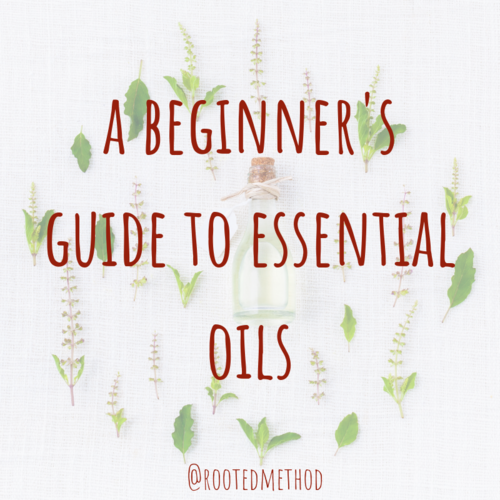
Essential oils are an integral part of my rewild lifestyle and I know they will add tremendous value to your own life. Below I have provided a beginners guide to information, benefits and uses that you can easily incorporate into your daily life!
Essential oils are an integral part of my rewild lifestyle and I know they will add tremendous value to your own life. Below I have provided a beginners guide to information, benefits and uses that you can easily incorporate into your daily life!
Hope you enjoy and cheers to plant power!
Essential oils are organic compounds extracted from plants with tremendous healing properties. Using essential oils for healing purposes is often called aromatherapy, which is a holistic treatment seeking to improve physical, mental and emotional health.
For over 5,000 years, many different cultures have used these healing plant oils for a variety of health conditions. They are often used for relaxation, beauty care, home cleaning and most often used as natural medicine.
Just adding some of the most common essential oils like lavender, frankincense, lemon, peppermint and tea tree oil to your natural medicine cabinet can:
Fight cold and flu symptoms
Relax your body and soothe sore muscles Heal skin conditions
Alleviate pain
Balance hormones
Improve digestion
Reduce cellulite and wrinkles
Clean your home
Used in homemade personal care products
Essential oils are extracted directly from the bark, flower, fruit, leaf, seed or root of a plant or tree, and just one drop can have powerful health benefits.
They are typically created through the process of distillation, which separates the oil and water-based compounds of a plant by steaming.
Essential oils are highly concentrated oils that have a strong aroma.
By concentrating the oils of these plants, you are literally separating the most powerful healing compounds of a plant into a single oil.
These therapeutic oils in plants protect the plant from insects, shield the plant from a harsh environment and help them adapt to their surroundings. By taking essential oils, you are harnessing the protective and healing powers of a plant.
Essential oils are composed of very small molecules that can penetrate your cells, and some compounds in essential oils can even cross the blood-brain barrier. They differ from fatty oils (like those in vegetables or nuts) that come from large molecules because they cannot penetrate your cells, so they are not therapeutic in the same manner.
Each and every essential oil contains compounds with unique healing and therapeutic benefits. Here are some of the most popular essential oils and how to use them.
Anti-bacterial, anti-parasitic and antioxidant protection.
Improves circulation, reduces varicose veins, lifts confidence and can help heal broken bones.
Improves respiratory issues like bronchitis, sinusitis, and allergies. Also invigorating and purifies the body.
Builds immunity, reduces inflammation, heals age spots, supports the brain and may help fight cancer.
Reduces inflammation, supports joints, improves digestion and relieves nausea.
Supports metabolism and cellulite reduction. Mix with coconut oil and rub on areas of cellulite or take a few drops internally with water.
Helps with relaxation, improves mood and heals burns and cuts.
Great to use in homemade cleaning products, improves lymph drainage and cleanses the body.
Natural antiseptic and can prevent or reduce infections. Also, supports beautiful skin, reducing stretch marks and hormone balance.
Powerful anti-microbial properties, can kill fungus and help you kick a cold fast.
Supports digestion, improves focus, boosts energy, fever reducer, headache and muscle pain relief.
Incredible for reducing skin inflammation and great for creating glowing skin. Add a few drops to your facial moisturizer. Also, one of the most valued essential oils in the world at $1000+ for 15ml.
Can naturally thicken hair so it is great to add to homemade shampoos. Also, it improves brain function and memory so it’s great to use when working, reading or studying.
Natural anti-bacterial, anti-fungal, reduces bad odors and can help stimulate the immune system.
The natural aphrodisiac that improves libido and can also improve energy.
Different oils can be blended together to enhance each’s energy or can be blended with a base oil to be used for massage, shower gels or body lotions.
Ready to let essential oils guide you back to health? Here are the four most common ways these healing oils are used today:
Topically
Essential oils have a very small size and the chemical weight of less than 1000m (m = weight of molecule). This means that essential oils are able to penetrate the skin and pass into the bloodstream and into different areas of the body for internal therapeutic benefits.
Aromatically
Using a diffuser can help you experience the benefits of essential oils. You can diffuse lavender to reduce stress, melaleuca to cleanse the air, wild orange to improve mood, frankincense for spiritual enlightenment and peppermint to improve focus and energy.
Ingestion
Essential oils can be used as a powerful form of medicine but it should be remembered that again, essential oils are powerful. Most essential oils are safe for internal use but a little bit goes a long way. Usually, 1-3 drops are plenty mixed with water.
Oils like peppermint, lemon, and frankincense have great internal benefits and can be taken with water. Other essential oils like clove and oregano need to be diluted and shouldn’t be taken internally for more than 1 week.
This is an excellent way to take advantage of essential oils to improve your beauty, home, and long-term health. Some of the best DIY recipes to use essential oils with include: shampoo, body butter, toothpaste, bug spray, lip balm and household cleaner.
Best Carrier Oils For Aromatherapy
Essential oils are extremely small so they can pass through the skin and into the body quickly. But if you want to keep the oils on your skin and dilute them to create more gentleness on the skin you can combine them with carrier oils.
These larger oils that come from the fatty part of the plant can increase the length of time the essential oils stay on your skin and also prolong the aromatherapy effects.Some people mistakenly think using carrier oils reduces the effectiveness of the oil but really it can be the opposite. Dilution increases the surface area of absorption and with certain oils can prevent sensitivities.
Common carrier oils include:
Almond oil Avocado Coconut oil Jojoba oil Olive oil
The good news is you can create your own skin and beauty products that are
more effective than any conventional product on the market. Here are some benefits of specific oils:
Calm irritated skin – lavender and roman chamomile Reduce age spots – frankincense
Thicken hair – rosemary and sage
Natural SPF skin protection – helichrysum and myrrh Improve acne – melaleuca (tea tree) and geranium
Essential oils for hair loss can make a significant difference at stopping it in its tracks. Oils of rosemary, lavender, and sage can all help naturally thicken hair by stimulating the hair follicles.
Clary sage and lavender support hair growth by balancing estrogen levels and rosemary essential oil works by inhibiting DHT (dihydroxy- testosterone) which stops hair loss. Here is how to naturally thicken hair with essential oils:
1. Put 10 drops of rosemary oil and 5 drops of lavender oil on different areas of your scalp.
2. Gently massage into scalp for 2 minutes.
3. Put a hot towel around your head and sit for 20 minutes. 4. Finally, wash hair with natural homemade shampoo.
Unfortunately, most people turn to chemicals sprays like DEET that is highly toxic to the body instead of using all-natural mosquito repellent and essential oil bug sprays. Here are the top essential oils to repel insects:
Rub or spray all over the body to repel bugs.
Having a homemade first aid kit on hand for the everyday wound, sting, sunburn, muscle pain or injury is always a good idea.
Essential oils are used widely as natural medicine but without the side effects of conventional drugs like aspirin and antibiotics.
Here are some of the most common essential oils everyone should have stored in their personal medicine cabinet:
Lavender – to heal burns, cuts, rashes, stings, reduce anxiety and help sleep after trauma.
Peppermint – to improve pain in joints, muscles, relieve digestive issues, reduce fevers, clear sinuses, improve asthma, bronchitis and relieve headaches.
Frankincense – anti-inflammatory, heal bruising, reduce scars, boost immunity and emotional well-being.
Melaleuca – anti-bacterial, anti-fungal, can be used to prevent and reduce infection and clean air of pathogens and allergens.
Other oils you may want to have on hand to makeover your medicine cabinet include: eucalyptus, oregano, and clove.
Hope this information aids you on your journey to be more rooted in nature! Feel free to drop me a line with questions in how I can help you with your essential oil journey!
Stay wild,
Cristina Schooler
Founder of The Rooted Method
Disclaimer: If you do fancy any of the oil for your own life, please consider purchasing them through the affiliate links in each individual description. The small amount of money from the oils goes to support this blog, business and helping you live a more nature-based life! Please feel free to contact me personally with any questions about how to use the oils in any way!
JULY 20, 2018 | BY CRISTINA SCHOOLER
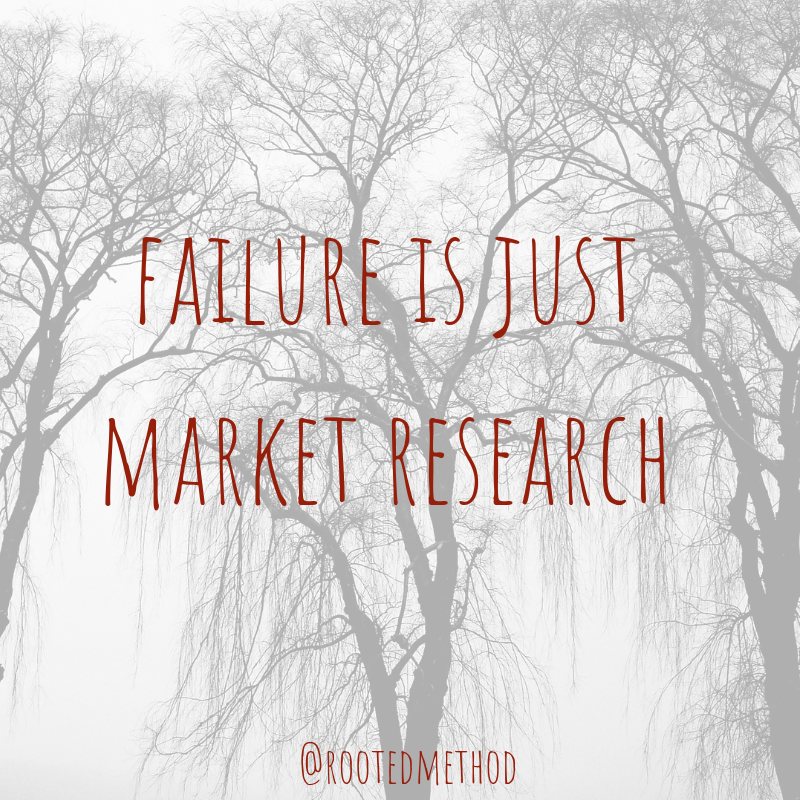
What did you fail at today?
Spanx founder, Sara Blakely was asked this question by her father at the dinner table growing and she attributes this practice as a breeding ground for her success. Before starting her global empire, she endured almost a decade of people saying no to her as a sales rep for Xerox machines.
What did you fail at today?
Spanx founder, Sara Blakely was asked this question by her father at the dinner table growing and she attributes this practice as a breeding ground for her success. Before starting her global empire, she endured almost a decade of people saying no to her as a sales rep for Xerox machines. With the tools she learned from her father at a young age, she knew that with every no, she was that much closer to a HELL YES.
I think there comes a moment in everyone’s life when you go “Aha!” all the failure was worth it. yup, I learned a whole lot and I get it now.”
As children, we scrape our knees, get really dirty, and bounce it off really quick. We do it naturally without thinking.
Then we get into an education system, a job system what have you- that rates success in a hierarchy, on test scores, on acceptance to colleges. On performance records. A risk is discouraged. Our responsibilities begin by paying for school, getting a job, etc. Uh oh, we start to lose the steam of resilience in our teenage years because no one ever told us again and again that failing was ok. No one told us it was ok to be a child, fall down and get up again.
In first grade, I distinctly remember sitting down with my parents on the couch when they told me I was being pulled out of first grade because I couldn’t keep up with the other kids.
I was being held back because of auditory processing, sensory issues and inability to sit still. Outside of my school life, it presented itself in struggling to keep my room clean, forgetting things all of the time and feeling shameful for not figuring it out of their way just to name a few. It would take me until my mid-twenties until I learned how to use those “disadvantages” as superpowers.
I loved school. I always have. Learning is my jam and always will be, so why was I being told I wasn’t good enough? Why was I being put in a lower class in my mind? This ideal was reinforced throughout high school, middle school and no matter how hard I tried in school, A’s never came to me. Heck, B’s were hard as hell to make no matter how hard I tried.
That deep frustration from grade school, not ever feeling like I could perform like my classmates resorted me to a means of cheating the system. I remember crying to myself in the shower on numerous occasions in my late teens and early twenties asking myself “ Why can’t life just be easier for me?”
It boiled down until a particularly low moment in my life when at 17 and in the midst of tests and college applications, hard work staying up until 1 am to keep up with my classmates in academics and still barely making good grades I decided to plagiarize an article for my school newspaper in a weak moment of late-night exhaustion.
I still get flutters in my heart thinking about one of the only times I ever saw my mom actually disappointed in me because she said: “I’d rather you fail a class than cheat.”
This low moment gave me an opportunity to solidify the importance of how you do things and not about the outcome.
It would be keeping in flow that everything in my life got easier from that moment on but failure popped up in my academic and professional life a whole lot more over the years. But you know what that low point taught me? A commitment to trying. Each new failure gave me insight into how to problem solve like a hoss, think creatively on my feet, be empathetic to all people and ultimately give me the most important asset in my life toolbox- resilience.
Resilience is what allowed Sara Blakely and many like her to achieve their goals in life. As
I’ve seen a common thread in many of the literature and research I’ve done over the years in psychology and business, it’s usually not the idea that makes someone succeed, it’s the ability to always look at failure as an opportunity for growth, success, and perspective.
We don't give kids enough credit for how wildly intelligent and sensitive they are. We should be encouraging risk-taking and imploring about failure in their lives. The earlier we expose kids to the importance of making mistakes, the more they can feel supported in all of the challenges that arise amidst life.
Failure breeds innovation, creativity and perhaps the greatest human gift of all- it teaches us that dusting off our knees is a crucial part of our life journey. And hey at the end of the day, the law of probability says that the more you fail, there likely you are to succeed.
What failure are you grateful for today?
Stay wild,
Cristina
APRIL 9, 2018 | BY CRISTINA SCHOOLER
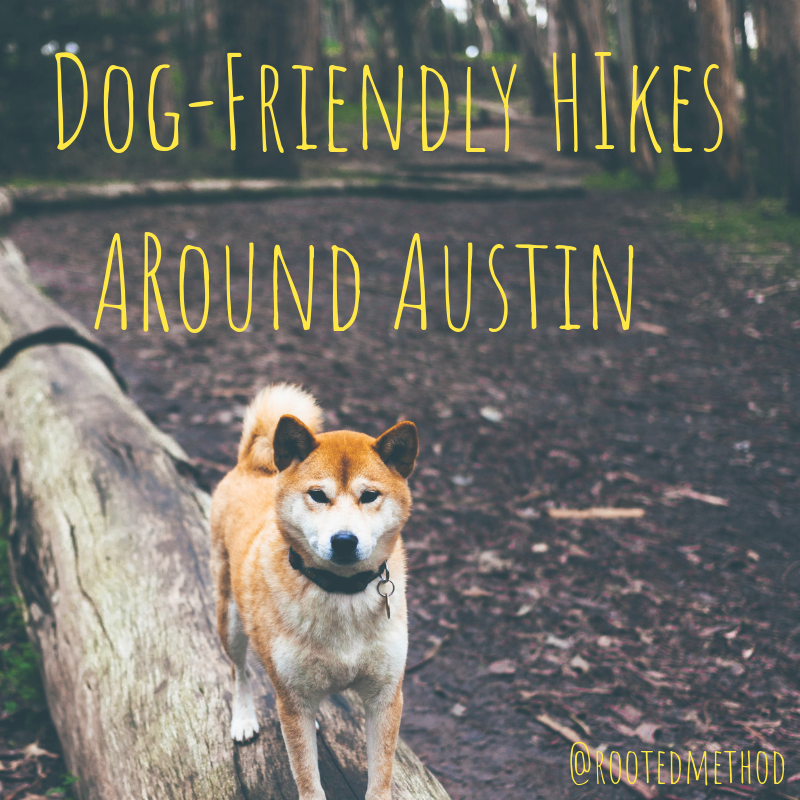
Tail wags (or butt wiggles) vigorously with excitement. Tongue is out, smile wide, eyes bright. Your furry friend prances around with eager anticipation. You’ve just announced it’s time for a w-a-l-k. But where do you take your favorite four-legged pal?
Tail wags (or butt wiggles) vigorously with excitement. Tongue is out, smile wide, eyes bright. Your furry friend prances around with eager anticipation. You’ve just announced it’s time for a w-a-l-k. But where do you take your favorite four-legged pal? Do you go on your regular route around the block or treat your pup to an outdoor adventure? Whether you’re new to Austin, just got your first dog, have yet to venture out of your neighborhood, or just want to add a few new places to visit, this is for you.
Austin was named America’s best dog city in 2017, and any walk around town will prove that it surely lives up to its title. While many public indoor spaces are dog-friendly, there is so much outdoor space that is waiting for your dog to roam free and do what dogs do best- explore! Here is a comprehensive list of dog-friendly hikes around the city, both on and off-leash, to get your nature fix with your hiking buddy:

One of Austin’s only off-leash trails, your dog will enjoy 2.8 miles of wooded adventure. Mostly rocky and rooted terrain, this is the perfect place to get your pooch feeling active. Your dog pal will have plenty of other dog friends to hike with along the way, and not to fret- there is a doggy bag dispenser at the trailhead for your doggy’s needs.
Distance: 2.8 miles
West Lake Hills
Open daily 5 AM-10 PM
1600 City Park Rd, Austin, TX 78730 (before the Emma Long gate)

Texas summers are brutal for us humans, which is why Austinites flock to swimming areas like Barton Springs Pool, an outdoor recreational pool filled with nearby natural spring water. Now imagine wearing a fur coat in this 100 degree heat. Hard to imagine, right? Our furry pals need to take a dip in some cold water, too. Thankfully, Barking Springs is right next door to the popular swimming pool, where humans and dogs swim together in harmony. Dogs roam free and play fetch with new friends all day long. Oh and did I mention it’s completely free?
Location: South Austin
2201 Barton Springs Rd, Zilker Park
Just outside (east) of the fenced-off Barton Springs Pool. You can park in the Barton Springs Pool parking area in Zilker Park.
Red Bud Isle
Sorry Wes Anderson, but Austin is home to the original Isle of Dogs. This lakefront off-leash dog park has 13 acres of open space for your curious doggo to sniff and explore for hours. Your pal can saunter through the island with other fur-iends and splash around in the surrounding water. You’ll get friendly waves from passing kayakers and canoers who also frequent this beautiful park.
Location: South Austin
Open daily 5 AM-10 PM
3401 Redbud Trail, Austin, TX 78746 (limited parking lot)

Less well known than the Barton Creek Greenbelt, Shoal Creek is a nicely shaded park with dog trails galore. It runs 3.25 miles from Lady Bird Lake to 38th street, and dogs are allowed off-leash between 24th Street and 29th Street, giving them over a mile of space to run as free as their doggy hearts desire.
Location: Northern Austin
Open daily 5 AM-10 PM
2631 Shoal Creek Blvd (parking address closest to leash-free section)

This park boasts 170 acres of off-leash doggy heaven. Onion Creek is perfect for a stroll through shaded trails or a game of fetch in the cool water for your pup to splash around in. With plenty of doggy bag stations around the park, you don’t have to worry about how to clean up after your pooch.
Location : South Austin
Open daily 5 AM-10 PM
7001 Onion Creek Dr. or 8652 Nuckols Crossing Rd

Yet another creek for a refreshing swim, Walnut Creek’s one acre off-leash park area is teeming with an adventure-filled day for you and your pup. The park has almost 300 acres of open land and with plenty of trails to choose from, you can’t get bored. Grab your hiking boots and waterproof shoes. Just be careful of all of the cyclists that frequent this park over the weekend- don’t let your energetic furball get run over!
Location: North Austin
Open daily 5 AM-10 PM
12138 N Lamar Blvd.

Just south of downtown within Town Lake Park, Auditorium Shores is the perfect place to bring your four-legged friend while also taking in sweeping views of Austin’s skyline. You’ll find 4.5 acres of off-leash fun for your pup to run free with other fur-iends. There’s a walking trail, water access areas to play in Lady Bird Lake and dog water fountains for Austin’s hot summer days.
Location: South/Downtown Austin
Open daily 5 AM-10 PM
900 W Riverside Dr.
Hill of Life Trail (Greenbelt)

Barton Creek Greenbelt’s Hill of Life trail is one of Austin’s best spots for those wanting a relaxing day tucked away under shady trees listening to the trickle of water passing by. The half-mile hike downhill (or uphill depending on the direction you’re coming from) is usually an extra challenge for mountain bikers or trail runners, but a great short hike before settling into a hammock with your furry pal in a creekside spot of your choosing.
Location: Southwest Austin
Open daily 5 AM-10 PM
1710 Camp Craft Road
If you’re looking for a slightly longer hike with your pup, River Place Nature Trail could be perfect. A 5.5 loop of various trails along a shallow creek, your dog will have a blast exploring the woods and making new friends along the way. There are a lot of stairs and elevation gain, though, so make sure you and your pup are prepared for a leg day!
Location: Northwest Austin
Open daily 5 AM-10 PM
8830 Big View Dr. or along River Place Blvd. (street parking in residential neighborhood)

One of my personal favorite downtown spots in Austin, this trail is a popular running and biking route along the river. Accessible from W Cesar Chavez St. or W Riverside Dr., you won’t go very far before running into other people walking their dog pals. Keep your furry friend on a tight leash if they have a lot of energy- it’s easy to run into bikers or runners on busy days.
Location: Downtown
Open daily 5 AM-10 PM
Parking lot across the street from the Austin Public Library: 710 W Cesar Chavez Street

One of the original trails on the Greenbelt, this is a go-to, dog-friendly hiking destination for everyone in Austin, soon to be the longest trail of its kind in central Texas (30 miles). You and your pooch will enjoy the various landscapes along this trail, from wooded dirt paths shaded by the surrounding trees that line plentiful creeks to white, rocky cliffs that tower above. Your pup will have plenty to explore along the Greenbelt, but be careful if you decide to let your furry friend off-leash anywhere along this trail- park rangers do check in from time to time (they are just trying to protect the nature that surrounds the trail).
Location: Downtown/Southeast Austin
Open daily 5 AM-10 PM
2201 Barton Springs Rd, Zilker Park
If you’re looking for a romantic evening with your furry friend, go venture to the top of Mt. Bonnell and watch the sun dip below the trees ahead. Standing at 775 feet, this is the highest point in Austin. While there are quite a bit of stairs on your trek to the top, you and your
pup will be blown away by the breathtaking views, and even happier that you got to share the experience together.
Location: Northwest Austin
Open daily 5 AM-10 PM
3800 Mt Bonnell Rd
Hope that this post gave you some inspiration to get outside with your furry friends!
Stay Wild,
Cristina
FEBRUARY 27, 2018 | BY CRISTINA SCHOOLER
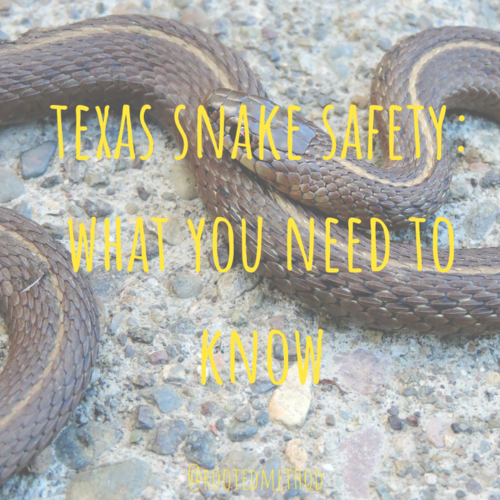
Snakes. It's what we Texans might get most worried about on our outdoor adventures. The good news is, the likelihood of someone being bitten is very rare.
Snakes. It's what we Texans might get most worried about on our outdoor adventures. The good news is, the likelihood of someone being bitten is very rare.
From Texas Department of State Health Services
Only 0.2% (1 out of 500) venomous snakebites result in death.
On average, 1 to 2 people in Texas die each year from venomous snakebites.
Roughly half of all venomous snakebites are “dry.” That is, the snake does not inject venom into the victim.
To give you some perspective, look at this chart that shows you the statistics of outdoor related deaths: As you can see, snakebites are very low on the totem pole. It's lightning that is more dangerous!

The State of Texas is home to 15 potentially dangerous snake species or subspecies. Despite this, each year, there have been more deaths in Texas attributed to lightning strikes than to venomous snakebites.
Pit vipers are venomous snakes that have an opening on each side of the head between the eye and the nostril. In Texas, we have 3 groups of these snakes: Copperheads, Cottonmouths, and Rattlesnakes.
Copperheads- These snakes are found in rocky areas and wooded bottomlands and are rare in dry areas. In the spring they can be found along streams and rivers, as well as in weed-covered vacant lots.

Cottonmouths- Cottonmouths can be dark brown, olive-brown, olive green or almost solid black. They are marked with wide, dark bands, which are more distinct in some individuals than in others

Rattlesnakes

Western massasauga (Sistrurus catenatus tergeminus), light gray, with brown oval blotches along the middle of the back and smaller blotches along each side. They are two feet in length and found through the middle of the state in grasslands, marshy and swampy areas.
Desert massasauga (S.c. edwardsii), lighter in color than the western massasauga, smaller and more slender. Found in the Trans-Pecos, western Panhandle and the lower Rio Grande Valley.

The brightly colored Texas coral snake is the state's only member of the Elapidae family, which includes the cobras of Asia and Africa. The coral snake is slender with a small indistinctive head and round pupils, and is usually is 2-1/2 feet or shorter. Its distinctive pattern is a broad black ring, a narrow yellow ring and a broad red ring, with the red rings always bordered by the yellow rings. Several harmless snakes are similarly marked, but never with the red and yellow touching. 'Red on yellow, kill a fellow; red on black, venom lack,' is a handy way to distinguish the highly venomous coral snake from nonvenomous ringed species. Coral snakes are found in the southeastern half of Texas in woodlands, canyons and coastal plains.
PDF link to more information on Texas snakes:
As our population continues to grow, and people continue to move into 'pristine' and 'untouched' areas, encounters with venomous snakes are going to occur. Many of these encounters occur around the home, with the result that incidents of bites close to home are statistically high.
Snakes in general, occur around a home for the specific purposes of seeking food and shelter. Keeping these things in mind provides us with guidelines to help prevent snakebite around the home.
Keep wood piles, brush piles, trash dumps and livestock pens as far as possible from the residence. When working in these areas, exercise caution. Never put an arm or leg into something if you can not see the bottom.
Keep storage areas and livestock sheds/barns as neat as possible. Treat tools and materials stored on the floor as possible snake shelters. Treat overturned boats, tarps and similar objects as potential shelter for transient snakes moving through the area.
Remember snakes are adept at finding their way through small openings. Keep this in mind when entering crawl spaces, basements, garages and similar areas.
Austin: 512-298-4791
Dallas: 214-974-0915
Fort Worth: 817-945-3371
Houston: 346-229-2116
San Antonio: 210-579-4727
First Aid for snake bites can prevent disability, disfigurement or death if it is applied effectively. The recommendations have changed drastically over the years, and remaining informed on effective first aid should be a priority of everyone working in snake habitat.
Assume envenomation has occurred even before symptoms appear.
Identify the species of venomous snake with care. This could help with the medical treatment but do not endanger yourself and become another victim.
Keep the victim as calm as possible. Keep yourself calm as well.
Know and treat for any symptoms of shock.
Wash the bite area with a disinfectant soap.
Remove restrictive clothing or jewelry in the area of the bite.
Prevent movement of the bitten extremity.
Get medical attention as soon as possible.
Under no circumstances should you cut between the punctures, or suck the venom out or apply electric shock.
If bitten,
Assume envenomation has occurred, especially if initial symptoms are present. Initial symptoms of pit viper bites include fang puncture marks; in addition, they almost always include immediate burning pain at the bite site, immediate and usually progressive local swelling within five minutes, as well as local discoloration of the skin. Initial symptoms of coral snake bites include tremors, slurred speech, blurred or double vision, drowsiness or euphoria and a marked increase in salivation within four hours; however, life-threatening effects from coral snake envenomation may not be evident for 24 hours or longer.
Identify the species of venomous snake that inflicted the bite, if possible, taking care to avoid another person being bitten. Identification is not necessary, but may be helpful.
Keep the victim as calm as possible. This helps reduce the spread of venom and the onset of shock.
Keep yourself and any other members of the group calm as well. This will help reassure the victim and ensure that the appropriate first-aid measures are followed, as well as preventing anyone else from becoming injured.
Know and be alert for the symptoms of shock, and institute the proper treatment should it ensue. Difficulty in breathing and/or kidney failure are frequent symptoms of envenomation.
Wash the bite area with a disinfectant if available.
Remove jewelry such as rings and watches, as well as tight-fitting clothes, before the onset of swelling.
Reduce or prevent movement of a bitten extremity, using a splint if possible; this helps decrease the spread of venom. For the same reason, position the extremity below the level of the heart.
Get the victim to a medical facility as soon as possible and begin treatment there with intravenous antivenom, crystalloid solutions and antibiotics. Antivenom treatment is generally most effective within the first four hours of envenomation, and is ineffective after 8-10 hours.
Do not make incisions over the bite marks. This can result in significant damage to already traumatized tissue, and can damage intact structures such as nerves and blood vessels, enhance bleeding caused by anticoagulant components of venom and increase the rapid spread of venom throughout the body if the circulatory system is compromised. A suction device, such as the Sawyer ExtractorTM, may be used without making any incisions. This device may remove significant quantities of venom, although its efficacy has yet to be conclusively determined.
Do not use a tourniquet or other constricting ban except in extreme cases of envenomation, and then only if properly trained in the technique.
Do not use cryotherapy (including cold compresses, ice, dry ice, chemical ice packs, spray refrigerants, and freezing) for the same reasons that the tourniquets should be avoided, and also because it can increase the area necrosis.
Do not drink alcohol, as it dilates blood vessels and increases absorption from the circulatory system, and thus helps spread venom faster.
Do not use aspirin or related medications to relieve pain, because they increase bleeding. A pain reliever not containing aspirin, however, may be used.
Do not use the pressure/immobilization technique, which consists of firmly wrapping the entire limb with an elastic bandage and then splinting, especially for pit viper bites. The theory behind this treatment is to confine the venom to the area of the bite until reaching a medical facility, but studies have shown the technique to be ineffective or worse with venoms which produce local swelling and tissue damage.
Do not administer antivenom in the field unless properly trained in the procedure, unless evacuation to a medical facility will take many hours or days, or unless envenomation has been extreme.
Do stay on wide trails when you are hiking if possible
Do stay on designated trails( especially in Spring season!)
Do wear high ankles boots if possible
Don't treat snake bites( get emergency help)
Do train your dog by taking a snake safety class
Do make sure you have emergency numbers and give someone your hiking plan if hiking solo
Hope this was helpful and happy spring hiking season!
Videos of Rooted Retreats
FEBRUARY 21, 2018 | BY CRISTINA SCHOOLER
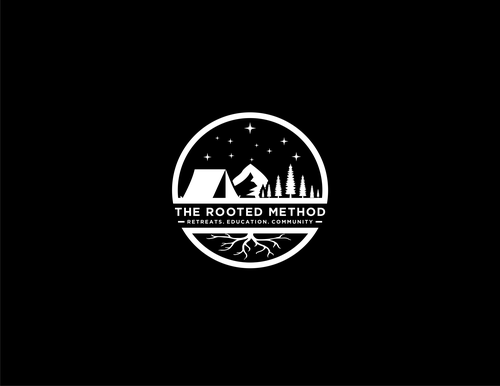
Here are some videos that highlight some of the adventures we have had and are currently creating. Hope if gives you some insight into our adventures camping, backpacking and leading workshops in the outdoors.
ROOTED RETREATS & SAKA ADVENTURES
ROOTED RETREAT TO BIG BEND NATIONAL PARK
PAST ROOTED RETREAT TO COLORADO BEND STATE PARK
FEBRUARY 13, 2018 | BY CRISTINA SCHOOLER
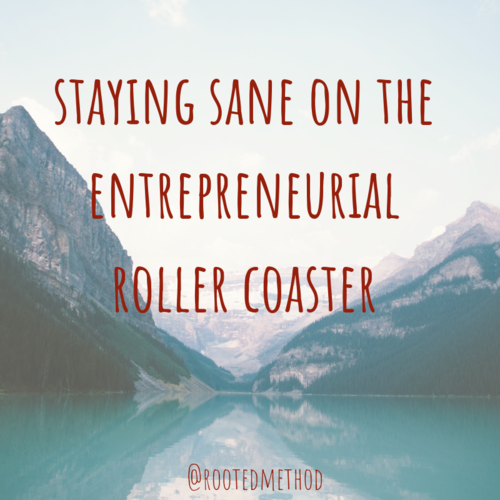
Last week after coming home from an incredible three day adventure retreat in a remote part of Texas, I cried. A lot. Not the soft cry of tears rolling down my face, but the big inhale, exhale dry heaving kind. The holding a pillow and shaking kind. I didn’t quite understand why I was sobbing so hard. Everything went so well and we had a great time.
Oh that’s right. I'm an entrepreneur and am riding along the emotional rollercoaster.
My boyfriend held me and said all of the wonderful things thoughtful partners say. I felt disconnected from myself. Disconnected from anyone and everyone in this moment. I was happy but exhausted. Tired. Overwhelmed. Unsure and Scared.
If you’re an entrepreneur, you might resonate or experienced a similar situation. I call entrepreneurship a game because if you’re not careful and check in with yourself, you might feel like it's winning against you. Those who enter this world the challenge and expect struggles along the way. However, at times your very sanity may seem to be slipping through your fingertips.
Running your own show can sometimes feel like a threat to your safety.
But remember: You deserve to feel good in your business.
In those intensely personal and challenging moments, I like to remember a few key points that bring me back to sanity and peace.
1. No one has ever or will ever deliver my unique sense of passion.
How cool is that? Every single person on this planet has the ability to offer something that no one else can. Own that. Celebrate it.
2. Reflection
I look back at my journals. Journaling over the last ten months has been the biggest blessing. Sometimes it’s hard to see how far you have come from day to day. Record your honest thoughts feelings and success over time, no matter how small.
3. Tune in
You will constantly receive mixed messages from your clients, family, friends, groups about how to run your business. Your intuition is so damn powerful. Listen to that feeling in your gut. Deep down you know the actions that are right for you and the well being of your business.
4. Nature
My most tried and true source of calm. When I get deep in my head, I think about the mountains. I think about the rivers. The sunsets. Of all of the beauty and abundance in this world that we get to experience. At the end of every single day I can always rely on having nature as my healer, guide and source of bounty.
5. Money is not the only form of success
Let me repeat that. Money is just an object we attach meaning to. If you don't address it in the face, it will consume your life.
I’m going to be straight with you all.
This one has been the hardest obstacle to overcome this past year. I had to do some deep work around detaching my success from my income. It’s still a work in progress but I can honestly say that when you work on this, the dams collapse and the river flows anew. Get real with money. Spend time developing your relationship with it.
It’s easy to become tied to your business like a lifeline. It may feel like an extension of you. It is not. I’d rather be making a whole lot less income and staying true to my values rather than making a whole lot of money and diverging from what I believe in. I believe that when we truly are in our element, the rest follows.
Maybe some or none of these resonate with you and that’s ok. Find ways to bring yourself back to calm and sanity. Consistently find practices to remind yourself of your genuine value, worth and magic.
Stay wild,
Cristina
JANUARY 16, 2018 | BY CRISTINA SCHOOLER
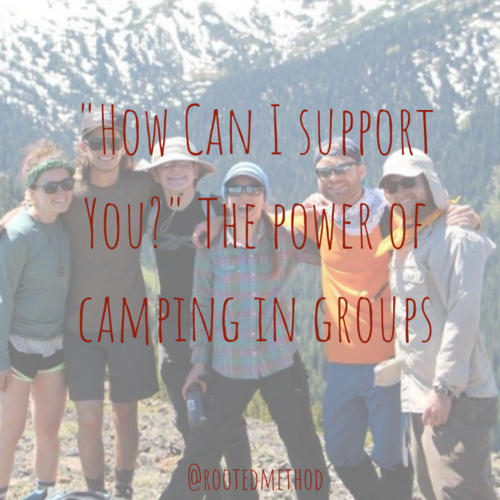
I sat there for thirty minutes trying to tie a hitch knot on my tent during a 10 day backpacking trip in Washington. This was an arduous trip with heavy loads on our backs.
Long days could sometimes lend themselves to individual frustrations in the campsite. For some reason, I could not grasp the knot. I tried and failed. I got frustrated and one of our instructors on our trip could tell. I was embarrassed that I was getting to worked up about a tiny knot.
She came and sat down next to me, calmly and helped me walk through the steps of tying this knot. She was patient, humorous and completely understanding of the frustration I was feeling. She sat with me for twenty minutes patiently. But it was one key question she asked me that shifted everything.
" How can I support you for your individual needs?"
This question helped me reflect and articulate exactly how she could help me. I disclosed to her that really small details with many steps have always been hard for me. After hearing that she approached the situation in such a way that completely allowed me to master that hitch knot.
What Audra was exhibiting is the foundation of any good camping or backpacking trip. It means taking the time to ask another how they need help. It means taking an extra load of food on the trail because your friend's back hurts. It means waking up a little earlier to make sure the group camp site is clean. It means being kind and compassionate even on the hardest of hiking days.
In work settings, home settings and any group setting for that matter we often stay silent about our needs because we believe they would be a burden to anyone else. We make up stories about how others will react by asking for help. However in the outdoors, you must rely on each other as a team. Tasks will not get done well or efficiently without communication and being open about needs.
In those traditional settings we also often too quickly give people the advice we think will help them. It comes from a good place but maybe giving advice too quickly isn't what they need. What if instead you took a minute to stop to your co-worker, employee or partner and asked them how you could help them in the best ways for their needs.
Imagine how your work or home life could change if you openly communicated your needs without fear of chastising. What would happen if your team new exactly how you could be supported and how you could support them in turn?It's easy to fall back on the idea that the world rests on our shoulders only. But in reality we evolved to function in groups, teams and communities where tasks were delegated on strengths and unique gifts that everyone brings to the table.
Blog
© Copyrights by THE ROOTED METHOD. All Rights Reserved.